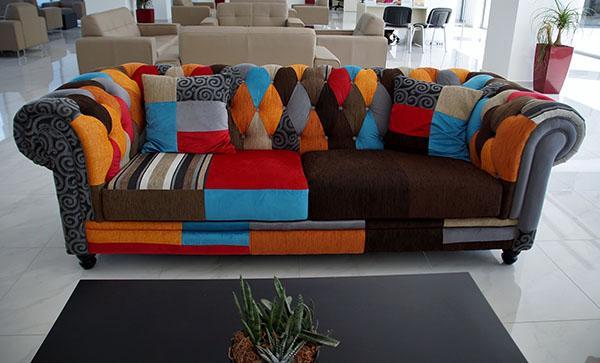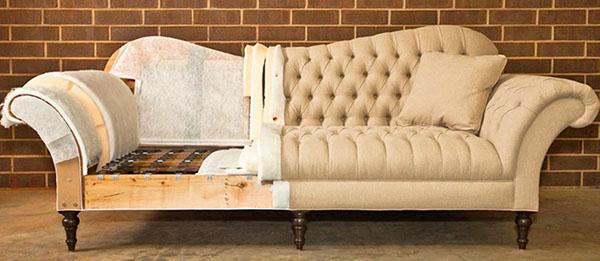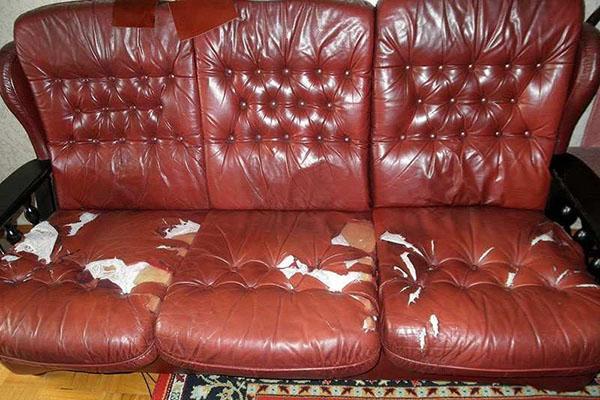Do-it-yourself sofa upholstery: stages of work at home

When the upholstered furniture falls into disrepair, the owner has only two choices: buy a new one in a furniture showroom or make a restoration of the old one in a specialized workshop. Do-it-yourself upholstery of the sofa will significantly save the budget and time spent on finding a master and transporting the product.
What is a sofa banner

Repair of upholstered furniture is a very specific process that requires knowledge of technology and properties of materials, certain skills in working with tools. In the furniture industry, there are several concepts that, for the layman, practically do not differ.
Nevertheless, initially it is worth determining what work can be done at home without resorting to the services of professionals:
- Padding is work on replacing the upholstery and interior filling of the sofa. May include minor redesign of the product. All work can be done at home without using a specialized tool.
- Repair of upholstered furniture is a process associated with restoring the functionality of the product. It may include the replacement of frame elements, repair or replacement of the transformation mechanism, and hauling. Do-it-yourself sofa repair requires knowledge in the field of joinery and plumbing, possession of a variety of tools. Such work is best done in a specialized workshop.
- Restoration - includes the repair of the frame in full or partial replacement of elements, hauling, restoration of functionality, design, paintwork, decor elements and accessories. All work is carried out while maintaining the original stylistic solution of the product. Furniture restoration implies a fairly extensive list of works, the performance of which is best left to a professional.
If you are not a professional furniture maker with a workshop equipped according to all the rules, then you can do only relatively simple work with your own hands - minor repairs and hauling of upholstered furniture.
How to pull a sofa with your own hands

The first thing to do is to determine the scope of work that needs to be done within the constriction.
As a rule, during the operation of the sofa, it becomes unusable:
- upholstery;
- foam rubber (latex);
- batting (sintepon);
A very common reason for restoration work is deformation and failure of springs and jamming of transformation mechanisms.

In the models of the first half of the last century, a lump (algae), sawdust and horse hair were used as a filler. In sofas of the second half of the 20th century, batting and an equalizing layer of foam rubber were usually used as fillers. For modern budget models, the springs are replaced by several layers of polyurethane foam, latex, padding polyester, pressed felt. In sofas of the middle and premium price segment, struttofiber or periotek are used as fillers - nonwoven materials with high strength and elasticity.

Spring sofas can be equipped with a dependent (independent) type of spring block or "snakes" that support the filler.

Sofas equipped with snake springs are no longer produced and are practically out of use.That is why we will consider the stages of work for a classic sofa-book with a spring block.
Do-it-yourself padding of a spring sofa includes:
- Dismantling the sofa into separate elements.
- Dismantling of upholstery, filling, spring block.
- Elimination of the drawbacks of the supporting frame.
- Laying new filler.
- Replacement of upholstery.
- Assembling the sofa.
Regardless of the condition, filling with hair, algae, sawdust, batting, felt must be replaced. Foam rubber and latex are changed as needed.
What is needed to stretch the sofa

To pull the sofa, you need to prepare some materials and a standard tool that almost any man has in the bins. The only thing that stands out from the standard set is a furniture stapler, which can be pneumatic, mechanical or electric. The first requires a compressor with a receiver, which is not worth purchasing for the sake of one constriction. Mechanical samples are autonomous and relatively cheap. The electric stapler is very convenient to use, but requires a power supply.
In addition, you will need:
- Screwdrivers, straight and curly. Significantly speed up the execution of work availability screwdriver with a set of nozzles and bits.
- Open-end wrenches for 12, 14, 17, 19.
- Hammer.
- Pliers and side cutters.
- "Gypsy" needle and nylon cord.
The choice of materials for the waist should be discussed in more detail.
Choice of upholstery fabric

Materials should be purchased as needed. In some cases, it is enough to simply sew up the upholstery, wash it (if there is minor damage) and re-stretch it on the soft part of the product. How to sew a sofa with your own hands? It's very simple: you need to remove the upholstery, put a patch on the inside of the damage, after which the cut can be reused.
If the upholstery has become unusable, then fabric will be required to sew the cover. The choice of material for upholstery is a very difficult process, because each fabric has certain properties and characteristics.
Among the most common upholstery materials are:
- Velor is a natural material that includes wool and cotton. Differs in high decorativeness, high safety margin, practically does not deform. Disadvantages: short service life, tendency to abrasion and fading.
- Flock is perfectly cleaned, so it is perfect for a home with children and pets. Durable and hypoallergenic material with low wear resistance.
- Shinil is a very decorative, durable and durable material that does not deform during operation. The disadvantage is low water resistance.
- Tapestry is an exquisite material with high strength and abrasion resistance. The disadvantage is the high stretch ratio, which creates certain difficulties when upholstering a sofa with your own hands.
- Jacquard has high strength and decorative properties. Disadvantage: low water resistance.
Among the large number of upholstery fabrics on the domestic market, one cannot but mention the various options for leatherette. These materials have excellent strength characteristics, resistance to moisture and abrasion, and ease of use. The disadvantage of all leatherette is flammability and deformation when exposed to high temperatures.
Filler selection

As noted above, the following can be used as a sofa filler:
- PPU is a synthetic porous material with different density values. During operation, it loses its elasticity and elasticity. For filling furniture, you should choose a material with a density of at least 30 kg / m2.
- Sintepon is an inexpensive synthetic nonwoven fabric with good elasticity. Differs in a short operational period.
- Periotek is a modern nonwoven material with high strength and elasticity.Perfectly restores its shape even after prolonged deformation.
- Structofiber is a high-strength and resilient material that does not rot and does not absorb moisture, and can withstand heavy loads.
- Batting is a canvas made of technical cotton wool. Due to its high density, this material is used to protect against springs.
- Pressed felt is a natural fabric that is used as protection for spring blocks. It is used with fillers of lower density (foam rubber, polyurethane foam, etc.).
In addition to the above materials, modern sofas can use holofiber in the form of a mat, which perfectly retains its structure during deformation. The most common material used in classic sofas in the budget price segment is foam rubber. Of all the fillers, foam rubber is the most fragile and cheapest material.
Since sofas are subjected to intensive use, experts do not recommend using foam rubber as the only filler.
Do-it-yourself sofa banner: disassembly process

To disassemble the sofa, you need to perform a number of operations:
- detach the armrests;
- unscrew the transformation mechanisms from the frame that hold the berth on the sofa pallet.
In principle - on this the disassembly process can be considered completed. Now that all the elements are in sight, you can assess the damage and determine the scope of work.
Removing the upholstery fabric

This is easy enough. Use a screwdriver to pry and pull out all retaining brackets. This process must be done as carefully as possible so as not to damage the upholstery fabric, which, even with severe wear, can be used as a template for sewing a new cover. The staple remover will significantly increase the quality and speed up the execution time of this work - a simple but effective tool that can be purchased very inexpensively at any specialized store.
Removing the filler

Layers of filler are hidden under the upholstery fabric. As a rule, in spring sofas it is foam rubber, under which there is batting, latex or other more modern non-woven material. Further, there can be a layer of felt or burlap, which play the role of an interlayer between the filler and the springs. If there is damage, then the entire filler or its separate layer must be replaced.
It is very easy to change the foam rubber in the sofa with your own hands, because this material is held on the filler or frame with the help of glue. We tear off the old and glue the new material For these works, any glue based on acetone, dichloroethane is suitable. You can simply purchase inexpensive and affordable glue # 88.
Examining the spring block

Springs in a sofa are most likely to be damaged by high loads. If there are no broken and squashed springs in the block, the block frame is intact and there is no backlash between the elements, then there is no point in replacing it. If there is at least one broken spring, then it is better to change the entire block at once. The thing is that replacing the springs in the sofa with your own hands is a very laborious process that requires certain skills, experience and the availability of tools. To change the block, it is tedious to remove the brackets holding it to the frame, install a new one in its original place, fix the frame on the frame with staples or nails.
When replacing, pay attention to the backing, which protects the frame from abrasion and helps reduce squeaks. For the substrate, it is better to choose a pressed felt sheet, 3-5 mm thick.
Build process

Now everything is simple: after installing the spring block, (if necessary) replace the filler layers, pull on the new cover and shoot it to the frame with staples, using a construction stapler. The last stage of stretching the sofa with your own hands is the assembly, which is carried out in the reverse order: installing the soft part on the frame, fixing the transformation mechanism, attaching the armrests.

In this publication, we examined in detail how to pull the sofa with our own hands step by step. In fact, the process of tightening upholstered furniture is very simple. The difficulty usually arises when creating and stretching a new cover. It is better to entrust cutting and sewing to specialists.
To avoid sagging of the fabric, make the upholstery of the sofa crosswise: start in front, then stretch the fabric and shoot from the opposite side. After fixing on four sides, you should pull the fabric between the back and the seat and "shoot" with staples to the frame.